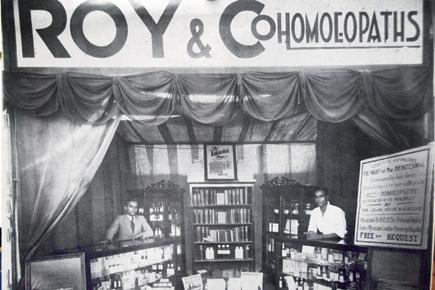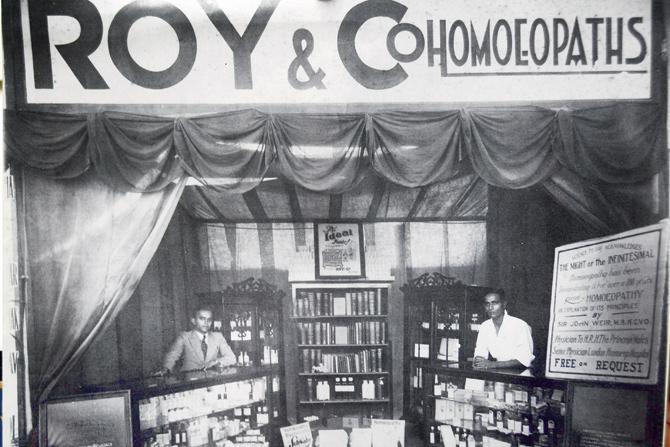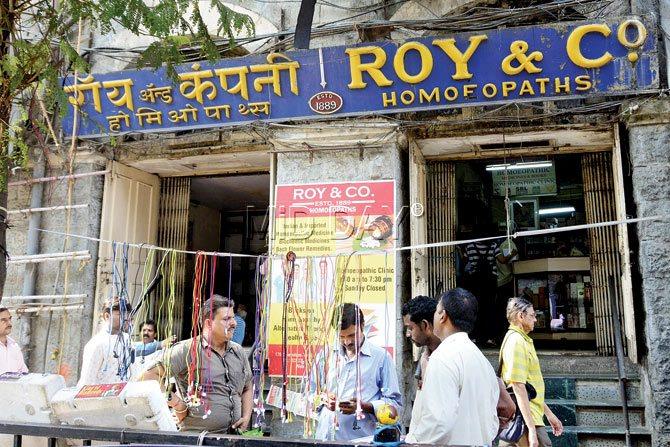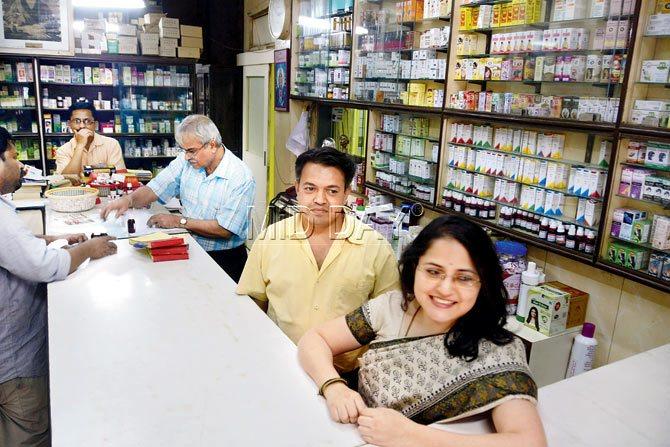Mahatma Gandhi was once treated here. Roy and Company, Maharashtra’s oldest homeopathy pharmacy at Princess Street has changed, and then not

ADVERTISEMENT
It’s easy to walk right past Roy and Company, and we nearly do. The unassuming exterior gives no inkling of the 127 years that have passed since its inception. What gives it away is the musty smell of old books, the high ceiling, rows of teakwood cabinets, an old typewriter and walls dotted with sepia-tinted photographs. Welcome to the state’s oldest homeopathic pharmacy at Shamaldas Gandhi Marg, Princess Street.

A photograph taken in the 1920s shows the second generation of the Kulkarnis — Manohar Kulkarni (left) with a staff member — at Roy and Company Homeopaths
As a slick pack of Roy and Co. hairdye jostles for space next to a brown translucent bottle of Arnica on the counter, it’s almost symbolic of the fine line between tradition and modernity that the pharmacy now toes. “This place is a labour of love of my great grandfather, Vishweshwar Kulkarni, who established it in 1889,” says Dr Tejaswini Kulkarni, a fourth generation member of the Kulkarni family that owns and runs the pharmacy. “So, we have tried to retain its old world charm in terms of decor. And, while we continue to to dispense authentic homeopathic drugs ranging from dilutions, mother tincture, Biochemic tissue salts and Bach flower remedies, we have branched out into more commercial products like toothpastes and shampoos to keep up with times. We also sell books on homeopathy,” she adds.

The pharmacy, started by Vishweshwar Kulkarni after he moved from Karnataka to Bombay, moved from Khetwadi to its present address in 1916. Pics/Bipin Kokate
The pharmacy was originally located at Khetwadi, near Edward Cinema, and moved to its current address in 1916. At about 50-100 metres distance from Roy and Company, there are another six homeopathic pharmacies including the Zoroastrian pharmacy and Parsi homoeopathic pharmacy.

Dr Tejaswini Kulkarni (extreme right ) and her brother Jitendra (centre), the fourth generation of the family, manage the pharmacy
In the early 1900s, the area around Kalbadevi was a thriving business hub. There was the cotton exchange, bullion and jewellery market in Zaveri Bazar, electrical goods market at Lohar Chawl and fabrics were sold at Mangaldas Jethabhai market. “So, being in an area like this, gave us access to more people,” says Jitendra, who manages the counter along with a loyal staff that’s been here for 40 years, including Dattanand and Anand Balwalli along with Bahadur Singh.
While we sit inside the clinic on sturdy wooden chairs that are at least half a century old, Tejaswini gets reams of A4-sized sheets out of her bag. “This is our family tree. And out of this clan, 28 members happen to be homeopathic doctors. So, when I say the love for homeopathy runs in our blood, it’s no exaggeration,” she laughs. Incidentally, other famous homeopathic pharmacies, Ray Brothers’ at Nana Chowk and Orient at Lamington Road belong to Tejaswini’s uncles, Dr Ashok and Dr Praful Ray Lakshman Kulkarni and Dr Ashok and his son Dr Deepak Kulkarni
respectively.
So, if the Kulkarnis are the owners, we are curious to know where the store gets its evidently Bengali name, Roy and Company from. “At that time, my great grandfather was given the title of Rai. The British officers pronounced it as Roy. Soon, people began addressing him as Roy, and he decided to retain it,” she says.
But, interestingly, its founder Vishweshwar Kulkarni was not a doctor by profession. “He had a job in the Post and Telegraph department in Vengurla, Karnataka. But, he would assist Dr Fellowitz, a German Jesuit priest and a homeopathic practitioner. When his compounder fell ill, my great grandfather was asked to fill in. That’s how he was initiated into the field,” reveals Tejaswini. Sharp and proactive, Kulkarni soon learnt the ropes by reading books on medicine and gaining hands-on experience. Fortunes changed when Kulkarni cured the ailing wife of a British officer. “In return, my great grandfather asked for a posting in Bombay, so that he could spread awareness about the field. Homeopathy was gaining ground in Calcutta, and its impact was being felt even in the city. So, he felt the time was ripe,” says the Bandra resident.
The challenge for Kulkarni was to prove the efficacy of homeopathy to people. “The basic premise of homeopathy: ‘like cures like’ — the same substance that could cause a reaction in a healthy person could also be a remedy for someone suffering from similar symptoms — was hard to buy. But in 1902, there was an epidemic of the pneumonic plague and many homeopathic practitioners treated most of the people successfully, which helped instill faith [in the therapy].”
By the 1920s, the second generation comprising Vishweshwar Kulkarni’s four sons were initiated into the business. Roy and Company soon became the chief importers of Mesers B & T (Boericke and Tafel) of America and Schwabe of Germany. Dr Cyrus Maxvell Boger’s treatise on homepathy called Boenninghausen Repertory was first published by Roy and Company in India. “He was the first to start manufacturing homoeopathic drugs in Maharashtra. He was also instrumental in starting the first Homeopathic medical college in the city, now known as CNPH (Chandaben Mohanbhai Patel Homeopathic Medical college) in Vile Parle. Even Mahatma Gandhi took treatment from him when he fell ill during a protest rally at Azad Maidan,” she says.
Tejaswini feels the popularity of allopathy centres hasn’t jeopardised business. “The massive population works to our advantage. Not everybody can afford allopathy treatment. Moreover, homeopathy is a natural, holistic, approach to healing, which takes into account the mental make-up of a person. Many ailments are psychosomatic in nature, for which allopathy doen’t always work. Quite often, allopathic doctors send their patients to us,” she smiles.
 Subscribe today by clicking the link and stay updated with the latest news!" Click here!
Subscribe today by clicking the link and stay updated with the latest news!" Click here!







